
Karlovac is a city in central Croatia. In the 2021 census, its population was 49,377.
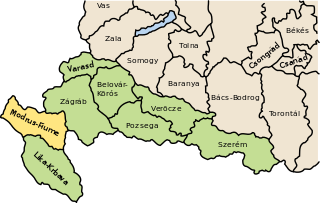
The Modruš-Rijeka County was a historic administrative subdivision of the Kingdom of Croatia-Slavonia. Croatia-Slavonia was an autonomous kingdom within the Lands of the Crown of Saint Stephen (Transleithania), the Hungarian part of the dual Austro-Hungarian Empire. Its territory is now in western Croatia. Modruš is a small town near Ogulin; Rijeka is a large city on the Adriatic coast. However, Rijeka was not part of the Modruš-Rijeka County, but under the direct administration of Hungary. The capital of the county was Ogulin.
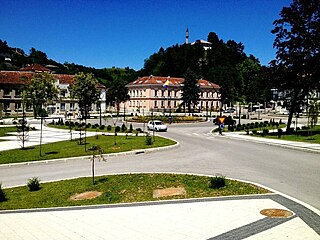
Cazin is a city located in Una-Sana Canton of the Federation of Bosnia and Herzegovina, an entity of Bosnia and Herzegovina. It is situated in northwest Bosnia and Herzegovina in the Bosanska Krajina region, near the border with Croatia. As of 2013, it has a population of 66,149 inhabitants. The municipality is often also called Cazinska Krajina. The town of Cazin is located on the main road which connects Bihać and Velika Kladuša.

Cetingrad is a municipality in Karlovac County, Croatia near Croatia's border with Bosnia. The population of the village itself is 319, while the total municipality population is 2,027 (2011). The municipality is part of Kordun. Cetingrad is underdeveloped municipality which is statistically classified as the First Category Area of Special State Concern by the Government of Croatia.

Velika Kladuša is a town and municipality located in the Una-Sana Canton of the Federation of Bosnia and Herzegovina, an entity of Bosnia and Herzegovina. It is situated in the far northwest of Bosnia and Herzegovina, located near the border with Croatia. As of 2013, it has a population of 40,419 inhabitants.

The Korana is a river in central Croatia and west Bosnia and Herzegovina. The river has a total length of 138.6 km (86.1 mi) and watershed area of 2,301.5 km2 (888.6 sq mi).

Delnice is a town in western Croatia, the largest settlement in the mountainous region of Gorski Kotar, in the Primorje-Gorski Kotar County. The town has a population of 4,379, and total municipality population is 5,952 (2011). Delnice is Gorski Kotar's main town.
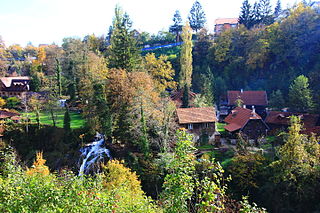
Rastoke is a village, located in the Town of Slunj, known for the Slunjčica River, which flows into the Korana River at Rastoke.
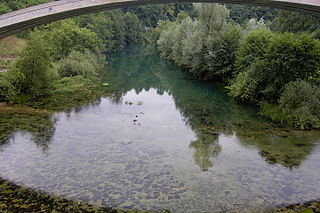
The Slunjčica is a river, which flows through the Kordun region in central Croatia. It partly flows underground through porous karst and surfaces in the vicinity of the city of Slunj. At Rastoke the Slunjčica leads into the river Korana, which reaches this point after passing the Plitvice Lakes National Park. The city of Slunj bears its name from this river. Due to its underground course the Slunjčica river has a quite cold temperature even during summer and the nearby situated towns use it as drinking water.

Plitvička Jezera is a municipality (općina) in central Croatia, in the eastern part of the Lika-Senj county, that lies in and near the eponymous Plitvice Lakes National Park, bisected by the D1 main road (Zagreb–Split). Its total area is 539.08 km2 The main town and seat of the municipality is Korenica. Smaller towns and villages are Bjelopolje, Jezerce, and Ličko Petrovo Selo.

Glina is a town in central Croatia, located southwest of Petrinja and Sisak in the Sisak-Moslavina County. It lies on the eponymous river Glina.

Krnjak is a village and a municipality in Karlovac County, Croatia.

Brod Moravice is a municipality in the Primorje-Gorski Kotar County in western Croatia.
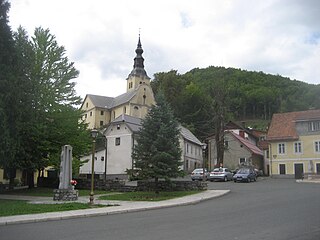
Čabar is a town in Primorje-Gorski Kotar County in western Croatia. There are 3,770 inhabitants, in the following settlements:
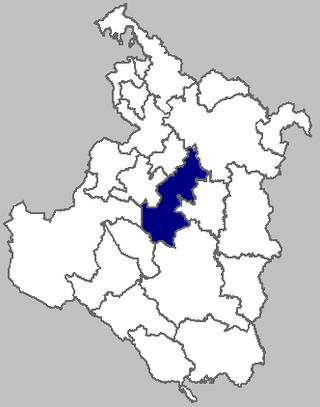
Barilović is a village and a municipality in central Croatia, in the Karlovac County.
The Battle of Logorište was fought east of Duga Resa and south of Karlovac, Croatia, from 4–6 November 1991 during the Croatian War of Independence, between the Croatian National Guard and the Yugoslav People's Army. The ZNG placed the JNA-held Logorište barracks under a blockade as part of the countrywide Battle of the Barracks, which aimed to pin down JNA units isolated in their bases and force them to surrender weapons and ammunition to the ZNG. However, the JNA garrison broke out from the besieged barracks with part of its stored equipment before the ZNG claimed the vacant base. The breakout was supported by JNA units and SAO Krajina units deployed to lift the blockade of the barracks and other JNA garrisons in Karlovac. A battle ensued as the ZNG attempted to contain advancing JNA units, ending with a ceasefire signed in The Hague.
The Cazin rebellion was an armed anti-state rebellion of peasants that occurred in May 1950 in the towns of Cazin and Velika Kladuša in the Bosanska Krajina region, as well as Slunj in Croatia, at that time part of Communist Yugoslavia. The peasants revolted against the forced collectivization and collective farms set up by the Yugoslav government following a drought in 1949, after which they had been punished due to their inability to meet the quotas. The ringleaders were persecuted and some killed, including many innocent civilians.

Budački or Gorica is a ruined castle on the left bank of the river Rijeka, which flows into the Radonja, a tributary of the Korana. It had a rectangular floorplan, and every corner had its own tower, making it one of the stronger fortifications of the region.






























